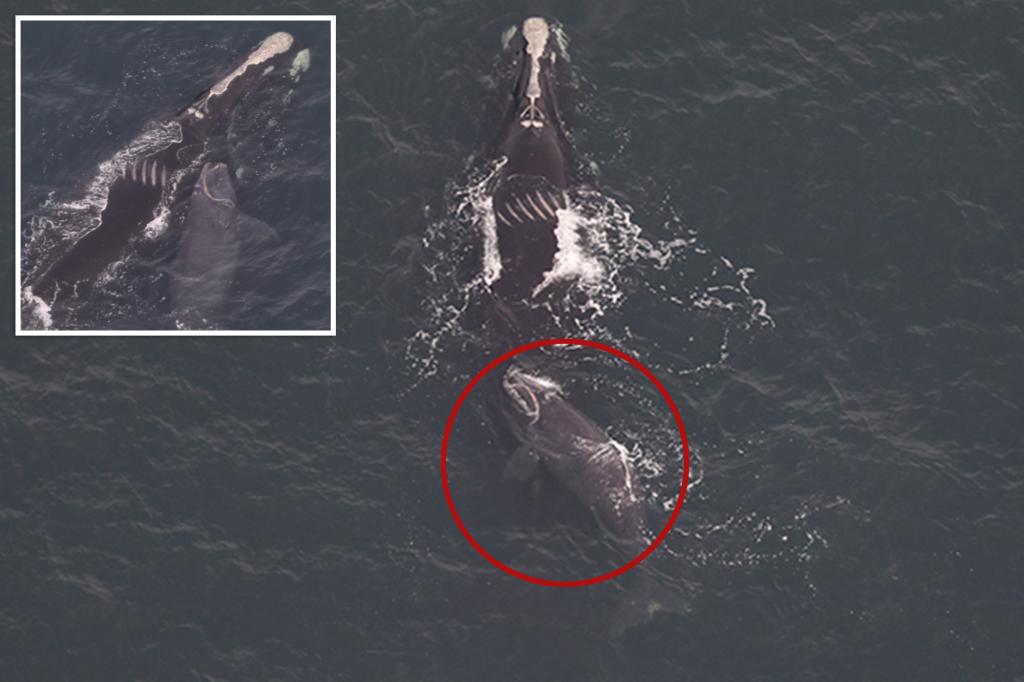World
Endangered whale and newborn calf make rare winter visit to NYC waters: ‘Sign of hope’

A Rare and Remarkable Sighting: North Atlantic Right Whales Spotted Near New York City
In an unexpected and thrilling turn of events, an endangered North Atlantic right whale and her newborn calf were recently spotted swimming in the icy waters off New York City. This extraordinary encounter marks a rare visit from a species that is critically endangered, with only an estimated 372 individuals remaining in the wild today. The pair, consisting of a seasoned whale named Accordion and her yet unnamed calf, was observed frolicking in the waters of the Port of New York and New Jersey, approximately 15 miles east of Sandy Hook, on February 3. While North Atlantic right whales are occasionally seen in the region during this time of year, the presence of a newborn so far north is a peculiar and significant occurrence that has captured the attention of researchers and wildlife enthusiasts alike.
The Uncommon Sight of a Newborn in Northern Waters
According to Chris St. Lawrence, a researcher from Gotham Whale, a South Brooklyn-based research organization, North Atlantic right whales are not uncommon in the New York Bight during the winter months. However, spotting a newborn in this region is highly unusual. Typically, these whales migrate south to warmer waters, such as those off the coast of Florida, to mate and give birth. New mothers usually remain in these southern waters until their calves are older before making the journey northward. The arrival of Accordion and her calf in the New York area has left researchers wondering whether the calf was born locally or if the pair traveled north shortly after the birth. This uncertainty underscores the unpredictability of these magnificent creatures and highlights the need for further study to understand their behavior and migration patterns.
A Glimmer of Hope for a Critically Endangered Species
The sighting of Accordion and her calf is a beacon of hope for a species that has been on the brink of extinction for centuries. North Atlantic right whales were decimated in the 19th century due to relentless hunting, earning them the nickname “right whales” because they were considered the most profitable to hunt—they float when killed, making them easier to process. Today, the species remains critically endangered, with fewer than 400 individuals remaining. The birth of a new calf is a rare and joyful event, offering a glimmer of hope for the recovery of this iconic species. Accordion, who has been tracked by researchers since 2011, is particularly notable for the distinct propeller scars on her back, which inspired her name. This sighting not only celebrates the arrival of a new life but also emphasizes the importance of preserving this species for future generations.
The Challenges of Coexisting with Human Activity
While the presence of Accordion and her calf in New York waters is a cause for celebration, it also raises concerns about the potential risks these whales face in such a busy and industrialized environment. Shipping lanes and vessel traffic in the New York Bight pose a significant threat to North Atlantic right whales. Their dark coloration and lack of a dorsal fin make them difficult to detect, and their tendency to swim near the surface increases the likelihood of collisions with ships. St. Lawrence expressed concern about the proximity of these whales to the bustling ports of New York City, where the risk of accidents is heightened. The challenges of protecting these whales in such a dynamic environment underscore the need for ongoing conservation efforts and public awareness.
Conservation Efforts and the Promise of a Brighter Future
Despite the numerous challenges, researchers remain optimistic about the future of North Atlantic right whales. In recent years, there have been encouraging signs of resilience within the species. For instance, during the summer of 2022, an unprecedented 82 North Atlantic right whales were documented in the New York Bight, a number that represents roughly a quarter of the global population. This unexpected surplus suggests that the species may be adapting to changing environmental conditions and finding new habitats. However, the unpredictability of their migration patterns makes it difficult to protect them effectively. As St. Lawrence noted, the key to safeguarding these whales lies in continued research, public education, and timely reporting of sightings. By staying informed and taking action, we can contribute to the conservation of this critically endangered species.
A Call to Action for the Future of North Atlantic Right Whales
The sighting of Accordion and her calf serves as a poignant reminder of the importance of protecting marine life and the delicate balance of our ecosystems. While the presence of these whales in New York waters is a source of excitement, it also highlights the urgent need for measures to safeguard their future. This includes reducing ship speeds in critical habitats, investing in acoustic monitoring technologies, and advocating for stronger marine conservation policies. Every sighting, no matter how unusual, offers a valuable opportunity to learn more about these incredible creatures and to reinforce our commitment to their survival. As we celebrate this rare and heartwarming encounter, we are reminded of the power of hope and the importance of taking action to protect the North Atlantic right whale for generations to come.
In conclusion, the appearance of Accordion and her calf in the waters off New York City is a rare and inspiring event that underscores the beauty and resilience of North Atlantic right whales. While the challenges they face are significant, the dedication of researchers, conservationists, and the general public offers a promising path forward. By staying vigilant, raising awareness, and supporting conservation efforts, we can help ensure that these magnificent creatures continue to thrive in our oceans for years to come.











